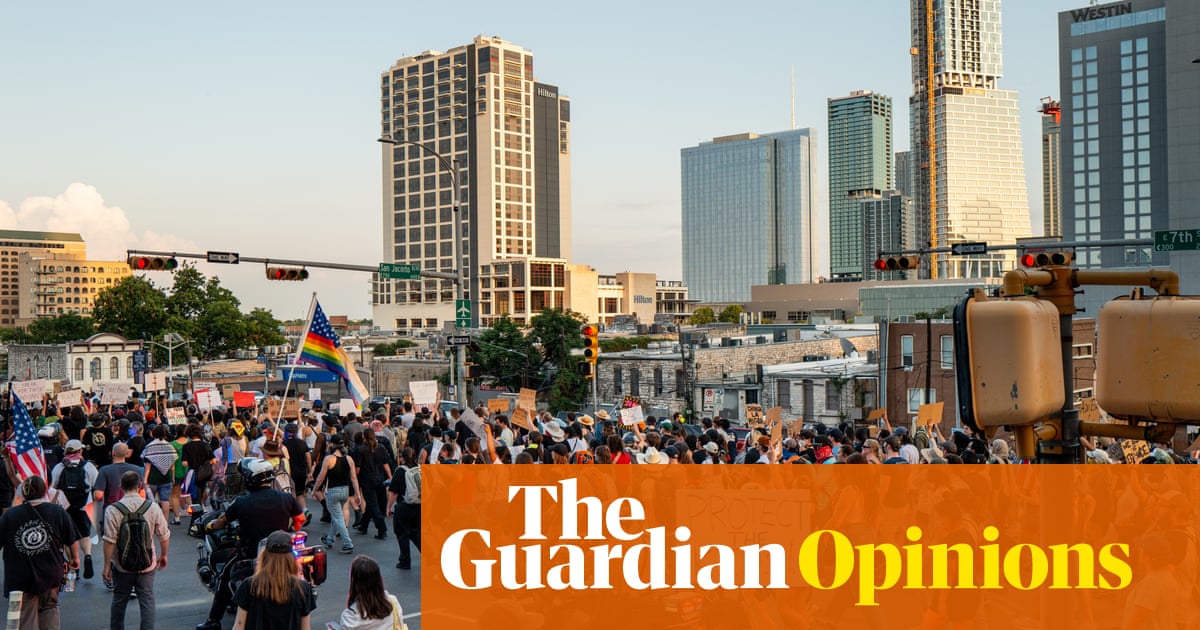We are relearning the meaning of “solidarity”. This week, across the US, people have been coming together.
We may disagree onimmigrationpolicy, but we don’t want a president deploying federal troops in our cities when governors and mayors say they’re not needed.
We may disagree on how laws should be enforced, but we don’t want federal agents to arbitrarily abduct people off our streets or at places of business or in courthouses and detain them without any process to determine if such detention is justified.
Or target hardworking members of our community. Or arrest judges. Or ship people off to brutal prisons in foreign lands.
We may disagree on questions of freedom of speech, but we don’t think people should be penalized for peacefully expressing their views.
We may disagree on the federal budget, butwe don’t believea president should spend tens of millions of taxpayer dollars on a giant military parade designed in part to celebrate himself.
As we resistDonald Trump’s tyranny, America gains in solidarity. As we gain solidarity, we feel more courageous. As we feel courageous and stand up to the president, we weaken him and his regime. As we weaken Trump and his regime, we have less to fear.
In downtown Kansas City, Missouri, this week, protesters holding signs reading “solidarity” marched peacefully. “I felt it was my right and my duty to come here – as what I had to go through to come here, and yell, and say I went through the system,” one of themtoldthe local channel KSHB.
In Denver, a crowdgatheredoutside the Colorado state capitol peacefully marched in solidarity with Los Angeles protesters, carrying flags and signs with slogans such as “Abolish ICE,” “No human is illegal” and “Keep the immigrants. Deport the fascists!”
In downtown Tucson, people gathered at the Garcés Footbridge to show theirsolidarity. Reminders of the protest were written in chalk on sidewalks: “No one is illegal on stolen land,” “Love over Hate” and “Free Our Families.”
In Boston, they gathered outside of the Massachusetts state house to express solidarity, citing two local students who they said Immigration and Customs Enforcement (Ice) abducted and detained for no reason,Rümeysa ÖztürkandMarcelo Gomes da Silva.
In Sioux City, Iowa,they marchedalong Singing Hills Boulevard, outside the Ice office, to peacefully protest. One of them, Zayden Reffitt, said: “We’re showing people that we’re not going to be silent and we’re not just going to let all this go through without us saying something about it.”
In Chicago, thousands marched through the Loop, creating a standstill on DuSable Lake Shore Drive near Grant Park. As one explained: “I’m a first-generation citizen – my parents were born in Mexico. It’s something I’m super passionate about. My family is safe, but there are many who aren’t. This is impacting our community, and we need to stand up for those who can’t speak up for themselves.”
In Des Moines, they rallied peacefully at Cowles Commons in solidarity with others. “We’re here to stand up for members of our community. For immigrants. For migrants. For refugees. For people with disabilities. For people on Medicaid. For seniors. For all the working class, because we are all under attack right now,”saidone. “And Trump is trying to scapegoat immigrants and make them the enemy, calling them criminals.”
In Austin, Texas, they gathered in front of the Texas capitol, holding flags and signs while chanting: “Whose streets? Our streets.” Authoritiesused pepper spray and teargasagainst the protesters and arrested more than a dozen of them, the governor, Greg Abbott, said.
In San Antonio, hundreds gathered outside city hall, chanting, “People united will never be divided!” and holding signs that read, “No human is illegal” and “I’m speaking for those who can’t.”
It was much the same in Sacramento; Raleigh, North Carolina; St Louis and in hundreds of other cities.
All across the US, people who have never before participated in a demonstration are feeling compelled to show their solidarity – with immigrants who are being targeted by Trump, with people who are determined to preserve due process and the rule of law, with Americans who don’t want to live in a dictatorship.
Peaceful protests don’t get covered by the national media. Most of the people who come together in places such as Des Moines and Kansas City to express their outrage at what Trump is doing aren’t heard or seen by the rest of us.
Yet such solidarity is the foundation of the common good. And although the number of people expressing it is still relatively small, it is growing across the land.
This is the silver lining on the dark Trumpian cloud.
Robert Reich, a former US secretary of labor, is a professor of public policy emeritus at the University of California, Berkeley. He is a Guardian US columnist. His newsletter is atrobertreich.substack.com
